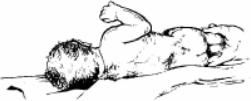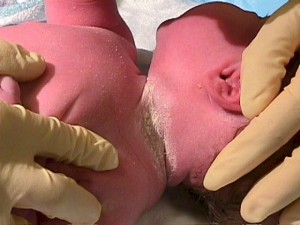The infant has delicate skin at birth that appears dark red because it is thin and layers of subcutaneous fat have not yet covered the capillary beds.
This redness can be seen through heavily pigmented skin and becomes even more flushed when the baby cries.
a. Vernix Caseosa.
This is a soft, white, cheesy, yellowish cream on the infant’s skin at birth (see figure 7-6). It is caused by the secretions of the sebaceous glands of the skin. It offers protection from the watery environment of the uterus, is absorbed in the skin after birth, and serves as a natural moisturizer. If there is a large amount of vernix caseosa present, it should be meticulously removed as it is thought to be a good culture medium for bacteria.


b. Lanugo.
This is a long, soft growth of fine hair on the infant’s shoulders, back, and forehead. It disappears early in postnatal life.
c. Mongolian Spots.
These are blue-black colorations on the infant’s lower back, buttocks, and anterior trunk. They are often seen in infants of Black, Indian, Mongolian, or Mediterranean ancestry. These spots occur less frequently in Caucasian babies. The spots are not bruises nor are they associated with mental retardation. They disappear in early childhood.
d. Jaundice.
This is a yellow discoloration that may be seen in the infant’s skin or in the scera of the eye. Jaundice is caused by excessive amounts of free bilirubin in the blood and tissue.
e. Petechiae.
These are small, blue-red dots on the infant’s body caused by breakage of tiny capillaries. They may be seen on the face as a result of pressure exerted on the head during birth. True petechiae does not blanch on pressure.
f. Milia.
These are tiny sebaceous retention cysts. They appear as small white or yellow dots and are common on the nose, forehead, and cheeks of the infant. They are of pin head size and opalescent. Milia is due to blocked sweat and oil glands that have not begun to function properly. They disappear spontaneously within a few weeks.
g. Birthmarks.
(1) These are small, reddened areas sometimes present on the infant’s eyelids, mid-forehead, and nape of the neck. They may be the result of local dilatation of skin capillaries and abnormal thinness of the skin. They are sometimes called stork bites or telangiectasia. These marks usually fade and disappear altogether. They may be noticeable when the infant blushes, is extremely warm, or becomes excited.
(2) A Hemangioma or strawberry mark is a type of birthmark that is characterized by a dark or bright red raised, rough surface. They do not develop for several days. They may regress spontaneously or may even increase in size. Surgical removal is not recommended. There is a “wait-and-see” attitude advocated before surgical removal.
